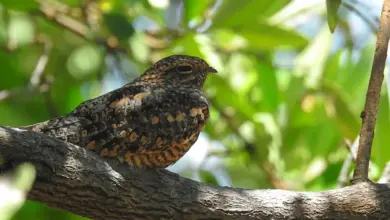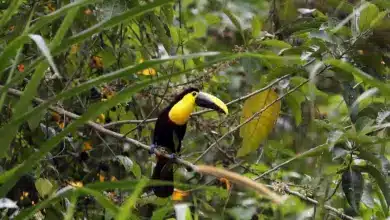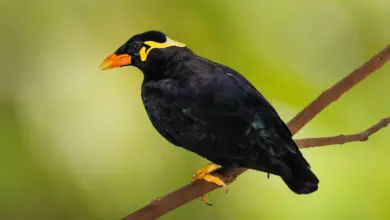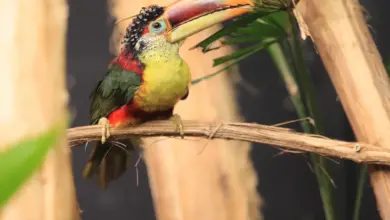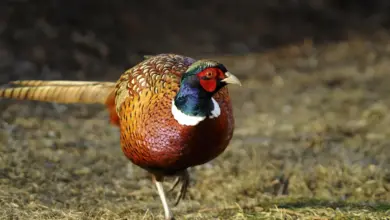Hill Mynas are endemic to tropical southern Asia from India, Bangladesh and Sri Lanka east to Indonesia, and the Common Hill Myna, a popular cage bird, has been introduced to the USA.
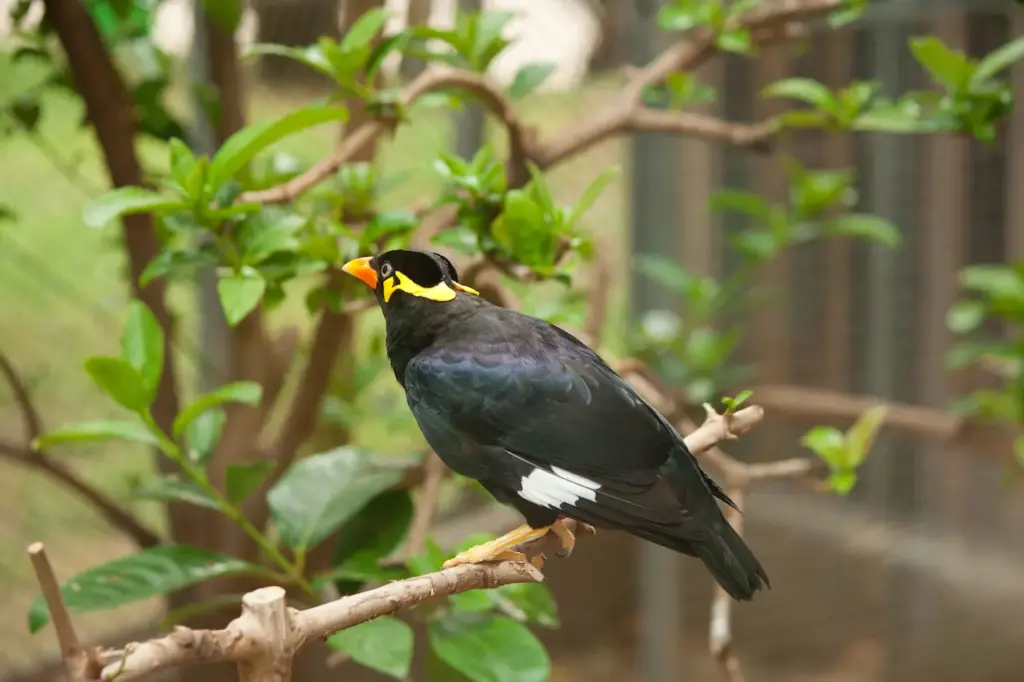
Species
There are four species of hill mynahs in the world, Gracula religiosa, G. ptilogenys, G. indica, and G. robusta.
There are obvious differences between the northern and the southern races of Thai hill mynah.
Southern Hill Mynas tend to have larger body than hill mynas in the north (Archawaranon and Techatraisak, 2002). Northern birds also have smaller beaks. One of the most obvious visual difference is the shape of the wattle. The northern race has a yellow connection line between front and rear parts (giving the appearance of an “u”), in contrast, the patches below and behind the eye in the southern race eye are separated. (Please refer to the photos below the listing of species for examples.)
- Common Hill Myna aka Java Hill Myna (Southern Race) – Gracula religiosa religiosa – Range from the southern part of Thailand to Malaysia and Indonesia.
Subspecies distribute all over Asia from India, China, Burma,Thailand, Laos, Cambodia, Vietnam, Malaysia, Indonesia and Philippines.Two of these are found in Thailand.
Andaman Hill Myna. Gracula religiosa andamanensis
Great Nicobar Hill Myna. Gracula religiosa halibrecta
Greater Indian Hill Mynah, Northern Race. Gracula religiosa intermedia – Range: Northern India, southern China, Burma, Laos, Cambodia, Vietnam, northern and central Thailand.
Palawan Hill Mynah aka Philippine Talking Mynah or Palawan Mynah, Gracula religiosa palawanensis
Greater Indian Hill Myna or Indian Grackle, Gracula religiosa peninsularis
Enggano Hill Myna, Gracula religiosa enggano
- Nias Myna, Gracula robusta – Endemic to the island of Nias in South East Asia and other nearby islands off western Sumatra
- Southern Hill Myna or Lesser Hill Mynahs, Gracula indica, formerly Gracula religiosa indica
- Sri Lanka Myna, Gracula ptilogenys
Northern race: Has a yellow connection line between front and rear parts (giving the appearance of an “u”)
Southern race: The patches below and behind the eye in the southern race eye are separated.
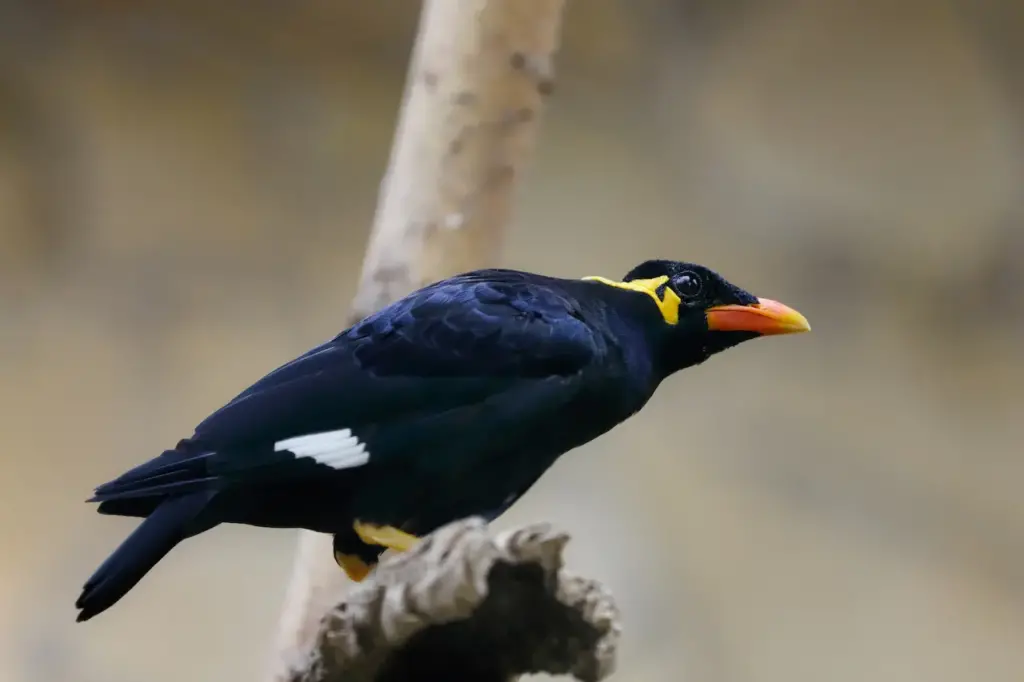
Description
These 25-30 cm long birds have glossy black plumage and when struck by the light you see a sheen of iridescent purple, turquoise and green. They have large white wing patches which are obvious in flight.
The bill and strong legs are bright yellow or orange, and there are yellow wattles (loose folds of skin) on the head, the shape and position of which vary with species. They have a bright orange beak that fades to yellow at the tip.
Males and females look alike.
Immature Hill Mynahs look like adults but the plumage is usually dull and may even have a ragged appearance until they have gone through the first molt. Juveniles also have duller beaks.
Vocalizations and Pets:
Hill Mynas are prized for their vocal skills for hundreds of years. Even though all Hill Mynas are capable of human speech, some are better than others. Some are able to talk with the same tones and clarity of speech as the human voice they mimic. The Hill Mynah has been described as the best talking bird in the world, indeed the champion of mimics!
Two species – Greater Indian Hill (Gracula religiosa intermedia) and the Common Hill Myna (Gracula religiosa religiosa) – are recognized as the most proficient talkers of the Hill Mynas and indeed of all talking birds, and these two species were the most widely imported for the pet trade than any other myna. The Common Hill Myna (Gracula religiosa religiosa) is the larger of the two and has a louder voice.
Lesser Hill Mynas or Southern Hill Mynas (Gracula religiosa indica) are also capable of learning words and phrases, but their voice has a higher pitch and they don’t have the tone ranges needed to imitate human voice as well as the Greater Indian Hill and Common Hill Mynas.
Breeding / Nesting
The northern race, Greater Indian Hill Mynah (Gracula religiosa intermedia) breed mostly during February to April, while the southern race, the Common Hill Myna aka Java Hill Myna (Gracula religiosa religiosa) breed mostly later during April to June.
Both races are cavity-nesting, non-excavating and monogamous; and their breeding activities are alike. They nest at the bottom of deep cavities (average nest height 23 m) with a long entrance (mean 45 cm) in tall trees. The average clutch consists of three eggs. Both parents prepare the nest, incubate the eggs and care for the young.
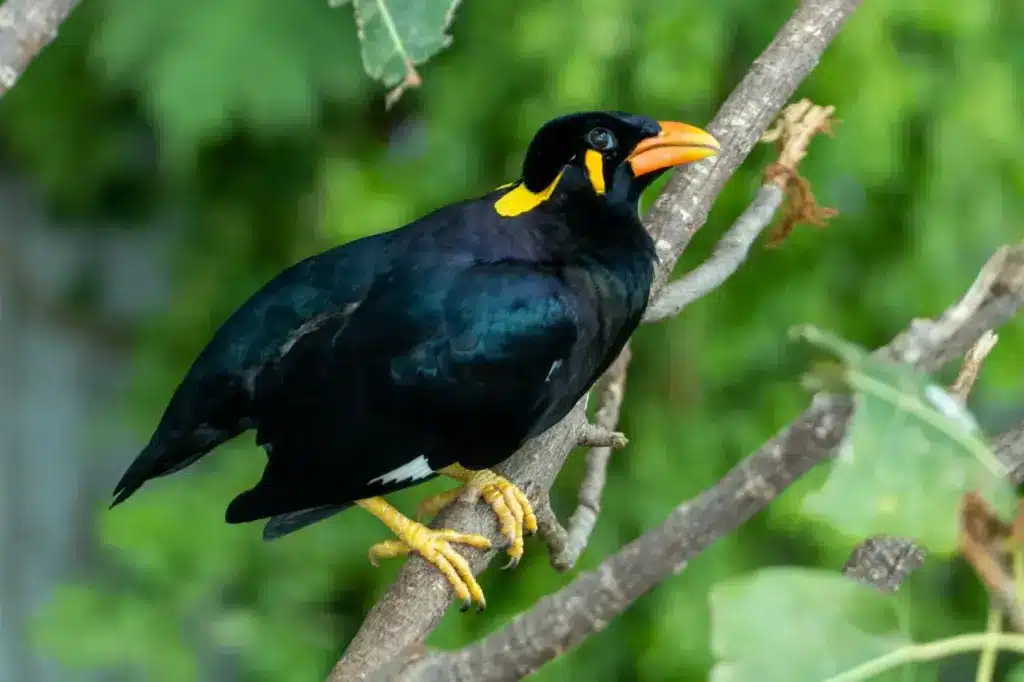
Diet / Feeding
Like most starlings, the hill mynas are fairly omnivorous. They feed on ripened fruit, especially figs. They also eat berries and seeds from a wide variety of trees and shrubs, and nectar from several kinds of flowers.
Occasionally they eat insects from the foliage of trees and termites. They may also eat a small lizard or other small mammal to feed to their babies during breeding season. Mynah breeders offer meal worms for this purpose.
Beauty Of Birds strives to maintain accurate and up-to-date information; however, mistakes do happen. If you would like to correct or update any of the information, please contact us. THANK YOU!!!
